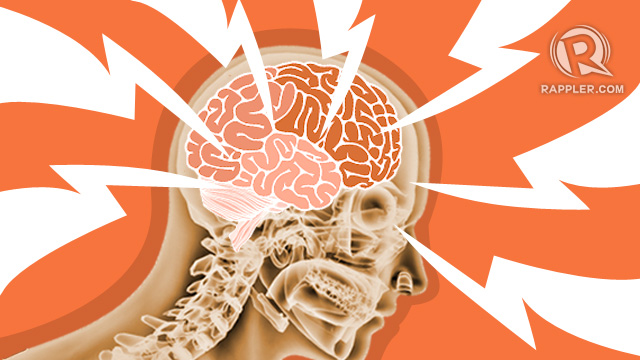SUMMARY
This is AI generated summarization, which may have errors. For context, always refer to the full article.
 On my fourth trip back to the motherland since 2009, I realized something very concerning. The Philippines, along with its Asian neighboring countries, was fast developing into one of the world’s infamous “brain attack” countries, a country succumbing to the ravages of stroke or what I call a “brain attack.”
On my fourth trip back to the motherland since 2009, I realized something very concerning. The Philippines, along with its Asian neighboring countries, was fast developing into one of the world’s infamous “brain attack” countries, a country succumbing to the ravages of stroke or what I call a “brain attack.”
In layman’s terms, a “brain attack” or “stroke” is a disease in which the blood supply to part of your brain is interrupted or severely reduced depriving brain tissue of oxygen or food. Brain cells will begin to die within minutes.
In fact, the common saying among neurologists is that for every minute of a stroke, a person can lose as many as 2 million brain cells – that’s more than the number of people who would fill up 120 fully-packed Araneta Coliseums. Hence “time is brain.”
Stroke in Batangas

My trip through Brain Attack Country started this year when I journeyed back to my mother’s home province of Batangas to gain reprieve from the bustling Manila hospital where I received training.
As I sat in the car on our way to Batangas, I couldn’t help thinking about how my patients in Manila would have fared very poorly if they lived in this province, hours from any Manila acute stroke unit.
What if I were an elderly Filipino man who had a stroke in Batangas? What would I do?
I was discouraged by how scarce hospitals and clinics seemed to be on our way to the heart of Batangas.
What would I do if I suddenly developed facial weakness, loss of movement and sensation in my arm or leg, loss of my ability to speak, or even worse, the worst thunderclap headache of my life? Would anyone around me in Batangas know what was happening to me? Would they bring me to the closest hospital as soon as possible?
You do not need to be a statistician to understand how devastating brain attack is in an increasingly westernized Philippines.
Brain attack country
The Philippine Department of Health (DOH) says that stroke, within the category of vascular disease, is the second leading cause of death in our archipelago nation, comprising 17% of deaths among the Top 10 killers in the country.
Our mortality rate from brain attacks nearly doubles that of the US and we join the ranks of our neighbors (i.e., Korea, China, Indonesia, India) in having especially high deaths from brain attacks.
|
Mortality rate for brain attacks |
|
|
Philippines |
USA |
|
71 people per 100,000 person years |
41.7 people per 100,00 person years |
It does not help that Asians also seem to have a higher genetic predisposition for narrowing of arteries in the brain (intracranial stenosis) and thus more likely to have a brain attack or stroke.
It would be incredibly difficult to have a brain attack or stroke in Batangas. Not only is there a scarcity of specialized stroke units, there is also such a scarcity of fresh vegetables and fruits being sold or eaten on the streets.
As I traveled throughout the province, I noticed that in place of plant-based, whole grain food on the road were sari-sari stores selling enriched flour biscuits, pastillas, and sachets of sugar in the form of powdered drinks, lost among stacks of bottled cola and baskets of deep fried chicharon and oily peanuts. (READ: Junk food vs Good food)
I realized again that the Philippines, especially in areas outside of Metro Manila, lacks access, not only to specialized stroke care, but also to healthy stroke-preventing foods.
This “double whammy” effect – unless averted by strong public health campaigns for healthy lifestyles – will likely spell disaster for most of the country in the next decade.
How to survive a brain attack

So the question remains: how can you survive in this Brain Attack country?
First things first: know what a brain attack is and go to the hospital immediately if you have any of the following signs. I think of the acronym “FAST.”
- F: Face drooping. Look for an uneven smile.
- A: Arm weakness. Is one arm weak? Can you lift both arms?
- S: Speech difficulty. Listen for slurred speech. Do people understand your speech?
- T: Time is brain. Go to the hospital, preferably with an acute stroke unit, immediately.
Ideally, the sooner you get to the hospital, the better your chances of receiving treatment that can potentially reverse the symptoms of your stroke (i.e., tissue plasminogen activator). There is, however, a substantial risk of bleeding with the use of the medication. Ask your physician about the risks and benefits of the use of these types of medications.
Also remember, an acute stroke is completely different from a heart attack. In a heart attack, the heart – not the brain – does not receive adequate blood and oxygen, causing heart cells to die.
Survival guide
Prevention of stroke is even more important than acute treatment since prevention arguably saves more Filipino lives than acute stroke units. The battle cry of public health is prevention, prevention, prevention!
How do you avoid a stroke? If I told you that there was a magic pill that would make you feel younger, more beautiful, and save you from brain attacks, heart attacks, diabetes, why wouldn’t you buy it?
The pill is lifestyle change, simply put, eating a healthy diet and exercising daily. Let’s explain this in more detail.
Here are my essential survival tips to prevent brain attack:
1. If you’re a smoker, stop smoking. Smoking doubles your lifetime risk of a stroke.
2. Know your blood pressure and aim for a blood pressure of less than 120/80.
3. Avoid sodas and reserve them for special occasions only. Same goes for sugary cookies and “energy drinks” or vitamin waters that often times are loaded with more sugar than conventional soda.
4. Learn to read nutritional labels, paying close attention to grams of sugar, fat and calories. (READ: Food myths)
5. Easy eating guide: About half of your plate should have vegetables and legumes. Avoid red meat and pork, try to get protein from plant sources.
6. Know the main risk factors for a stroke: high blood pressure, smoking, high cholesterol level, and diabetes.
7. Time is brain! Go to the hospital immediately upon suspecting a stroke, preferably with an acute stroke unit, immediately if you have a stroke.
8. Exercise daily and be “SMART” about your goals in exercising: Specific, Measurable, Attainable, Realistic, and Time-bound.
With a few lifestyle changes, we can work as a country to prevent stroke. Let’s stop brain attacks in the Philippines! – Rappler.com
Sources: Mayo Clinic, Philippine Department of Health, American Heart Association, Stroke Society of the Philippines, American Stroke Association, the Center for Disease Control (CDC) and other medical journals
Antonio Moya is a first year neurology resident at New York Presbyterian Weill Cornell Medical Center. He has traveled extensively throughout Asia since 2008 when he was awarded a U.S. Fulbright Fellowship to study acute stroke units and telemedicine in the Philippines. Having completed medical training at UCSF School of Medicine and his Master of Public Health degree at Harvard, Antonio hopes to continue advocating for underserved patients and promote public health in neurology worldwide.
Add a comment
How does this make you feel?
There are no comments yet. Add your comment to start the conversation.